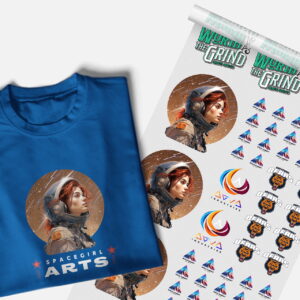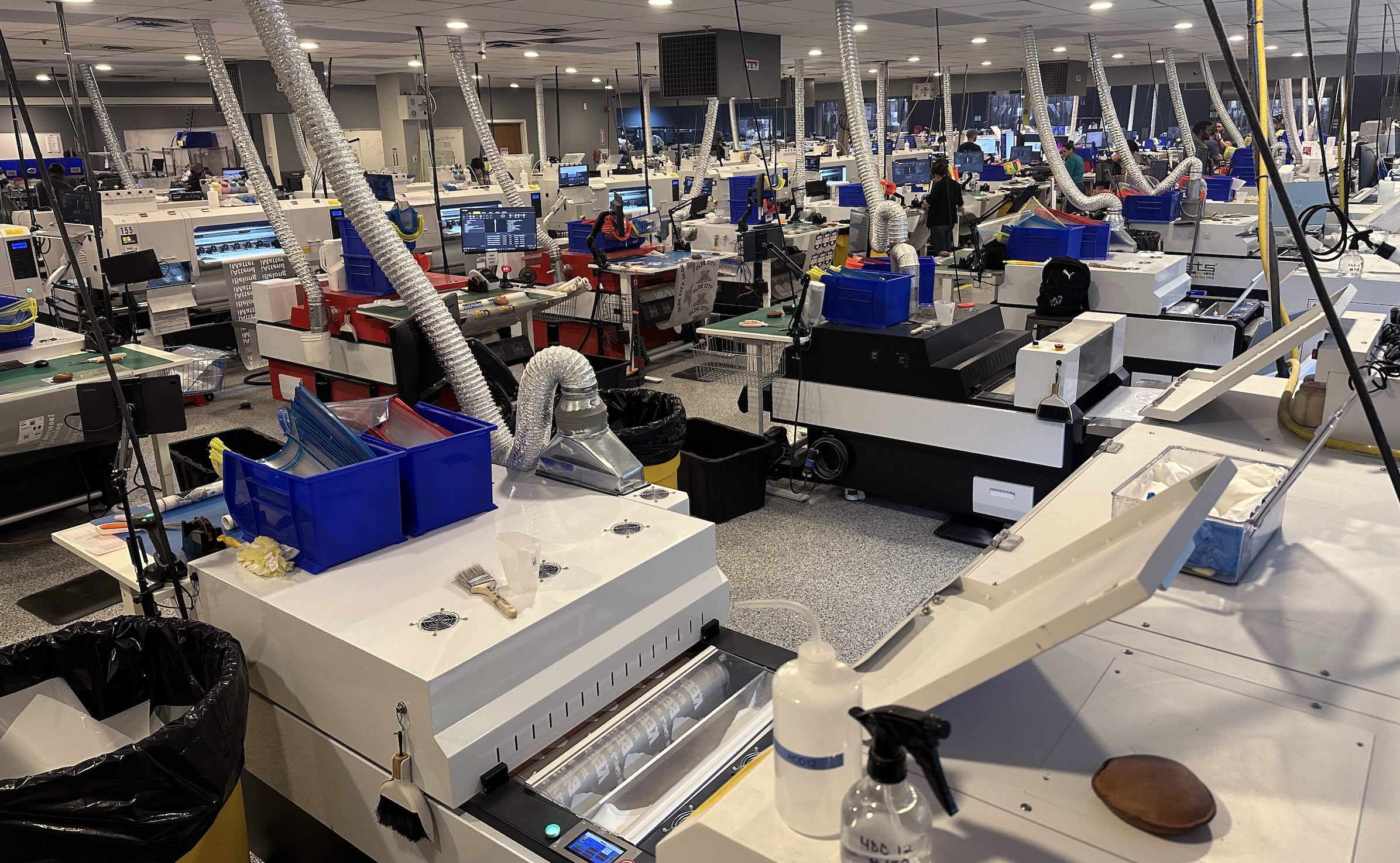How to spot (and avoid) cheap direct-to-film prints when outsourcing production of your custom heat-press transfers
When it comes to direct-to-film (DTF) printing, the old saying rings true: you get what you pay for. Whether you’re launching a custom apparel business or scaling an established operation, understanding the differences between a top-tier DTF transfer and a cheap knockoff can make or break your brand. This isn’t just about looks—it’s about durability, vibrancy, feel and, ultimately, a customer’s long-term experience beyond their initial few orders.
At my company, Ninja Transfers, we’ve seen firsthand how the quality of a transfer can affect an entire project. Our mission has always been to deliver consistent, premium results—and to help you understand what separates the good from the great.
In this article, we’ll break down what separates a high-quality DTF transfer from a low-quality one, what materials and methods go into the best transfers, and how you can spot red flags before making a purchase.
The Problem with Poor-quality DTF Transfers
Low-cost DTF transfers may seem like a good deal—until they start to crack after a few washes, peel at the edges or look dull after you peel the film. For small shops and larger brands alike, these failures can lead to lost time, spoilage of garments, unhappy customers and late deliveries, ultimately damaging your reputation.
So, what causes these issues? It often comes down to cutting corners: cheaper materials, outdated printers, alignment issues, banding issues, rushed or inconsistent curing processes or poor quality-control. The result can be a transfer that may look passable at first glance, but falls apart under real-world conditions.
The solution on the supplier side—and the thing you as a custom decorator need to be aware of when outsourcing your DTF transfers—is the existence of a well-executed production process capable of catching or preventing these kinds of problems before they have a chance to reach your heat press.
1. DTF Ink Quality
The ink used in DTF transfers directly affects color vibrancy, longevity of the color spectrum, color depth and adhesion. Top-tier inks deliver:
- High-opacity whites that in turn provide a solid base layer; especially important when printing on dark garments
- Rich color saturation that doesn’t fade quickly
- Flexibility to prevent cracking or breaking as the fabric stretches or moves
- OEKO-Tex certified safety to ensure they are non-harmful to humans
Cheaper alternatives may use thinner or lower-grade CMYK inks that look dull, are not safe for humans and can wash out in just a few cycles.
How to spot bad ink: Colors that seem muted or inconsistent, transfers that feel thick or are flaky, fade quickly or create a chalky feel often point to poor ink.
2. TPU Powder Quality and DTF
Thermoplastic polyurethane (TPU) powder acts as the adhesive that bonds a design to the garment. However, not all powders are the same. High-quality TPU powder:
- Melts evenly
- Adheres strongly to both the film and the fabric
- Remains soft and flexible after pressing
- Is as lightweight as possible while still durable
Low-quality powder can leave a residue, especially around the edges of the design, cause stiff patches or lead to lifting and cracking.
How to spot bad powder: If you notice a gritty texture, inconsistent application across multiple orders or if a design starts lifting after a few washes, chances are you’re dealing with inferior TPU powder.
Reputable companies, like Ninja Transfers, know the importance of TPU powder and will always pay for a higher-quality product. At Ninja Transfers we’ve tested dozens of TPU powders over the years to find the one we use today, which strikes the perfect balance between durability and softness.
3. DTF Transfer Film Quality
The film is the carrier for the ink and powder prior to the transfer process. Not surprisingly, its quality plays a huge role in the end result. A high-quality PET film will:
- Allow clean, predictable, easy peeling at any peeling speed, hot or cold, depending on the type of transfer
- Withstand high temperatures without warping
- Leave no residue behind
- Have a matte finish, rather than a shiny finish
Low-grade film can cause:
- Ink bleeding at the time of print
- Ghosting (a faint, unwanted outline around the design)
- Unpredictable peeling
- Locked peeling, where the film will not peel without ripping up the design
How to spot bad film: Difficult peeling, warping during pressing or jagged edges after pressing are all signs of poor film quality. As is the case with TPU powder, a reputable custom-transfer provider will source the best film it can. It will also continually test its film to ensure consistent results with clean peels and no post-press surprises.
4. The DTF Printing and Curing Process
Even the best materials can fail if a custom DTF provider fails to employ the correct production processes. High-end DTF providers take the time to dial in their curing and heat-pressing processes. That means:
- Properly drying and curing the ink/powder mix at the right temperatures for the right amount of time
- Controlled production conditions that avoid contamination or humidity issues
- Cheap operations will often rush these steps, leading to incomplete curing, uneven edges or brittle transfers.
How to spot bad curing: Transfers that feel overly stiff, lift at the edges or smell strongly of chemicals may not have been properly cured.
At Ninja Transfers, we make a point of calibrating our curing process daily to meet strict production tolerances. Failure to do so on the part of many lower-end operations can result in transfers that won’t adhere properly or fall to pieces after only a few washes.
5. DTF Quality Control & Consistency
This is the “invisible” work behind the scenes of great DTF prints. High-quality shops perform random testing, inspect for defects and maintain strict environmental controls (think humidity, air turnover and dust). They regularly reject prints that don’t meet their standards. The resulting prints are then shipped in a way that will not damage or fold the films during packaging or delivery.

Quality DTF transfers don’t just look good. They feel good and are capable of standing up to dozens of wash cycles. Photo courtesy of Ninja Transfers
Printers with only limited capacity or the inability to employ these kinds of quality-control standards may skip these steps entirely, which can result in transfers arriving folded, scratched or exhibiting problems with things like color consistency. This is not to say they’re doing so on purpose or being deliberately malicious, just that they lack the time, capacity or processes to ensure true quality.
How to spot poor QC: Look for variations in color, banding, ink starvation, print-alignment issues or packaging that allows for creasing or damage in transit. Higher-end companies perform multiple QC checks to ensure these kinds of things never have a chance to become an issue for their customers.
Why Outsourced DTF Quality Matters to Decorators
Whether you’re decorating shirts for a local event or fulfilling high-volume online orders, the quality of your transfer is your product. Customers may not know the difference between TPU and PET film, but they will notice if their new shirt is overly shiny or cracks in the wash.
Bottom line: high-quality DTF transfers will save you money in the long run by reducing waste, re-prints and returns. They will keep your customers happy and your designs looking sharp.
When comparing providers, don’t base your decision on price alone. Ask questions about materials, sample orders and durability testing. A little research will lead to better margins, predictable delivery and quality, and fewer headaches in general.
Final Thoughts on Custom DTF Quality
Again, all DTF transfers are not created equal, and while it might be tempting to go with the lowest-cost provider you can find, the true cost of inconsistent quality adds up fast.
If you care about clean application, bold colors, soft matte finishes and long-lasting results, you need to know what goes into a great DTF transfer. From ink and powder to production processes and quality control, every step matters.
Understanding these differences will help you make smarter purchasing decisions—and ultimately, build a better apparel business.
Brian Cass is a printing expert with Ninja Transfers and co-host of the company’s weekly “Between Two Bamboos” YouTube broadcast. For more on Ninja Transfers and its complete line of custom heat-press products and blank apparel, visit ninjatransfers.com.





